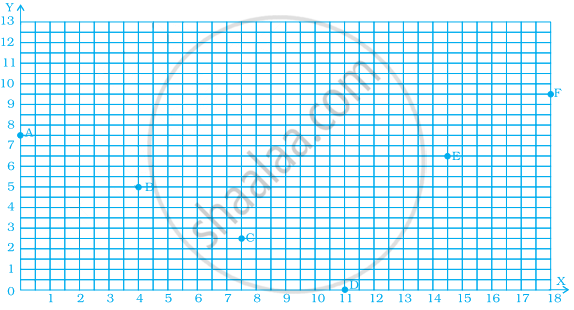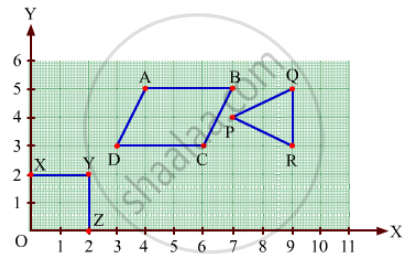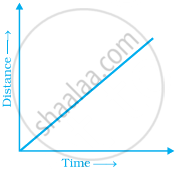Advertisements
Advertisements
प्रश्न
Find the coordinates of all letters in the graph given below.

उत्तर
The point A is on the Y-axis at a distance of 7.5 units from the origin.
∴ The coordinates are (0, 7.5).
The point B is at a distance of 4 units from Y-axis and 5 units from X-axis.
∴ The coordinates of B are (4, 5).
The point C is at a distance of 7.5 units from Y-axis and 2.5 units from X-axis.
∴ The coordinates of C denotes (7.5, 2.5).
The point D lies on X-axis at a distance of 11 units from the origin.
∴ The coordinates of D are (11, 0).
The point E is at a distance of 14.5 units from Y-axis and 6.5 units from X-axis.
∴ The coordinates of E are (14.5, 6.5).
The point F is at a distance of 18 units from Y-axis and 9.5 units from X-axis.
∴ The coordinates of F are (18, 9.5).
APPEARS IN
संबंधित प्रश्न
Write the coordinates of each of the vertices of each polygon in Fig. 27.9.

The following table shows the amount of rice grown by a farmer in different years:
| Years: | 2000 | 2001 | 2002 | 2003 | 2004 | 2005 | 2006 |
| Rice grown (in quintals): | 200 | 180 | 240 | 260 | 250 | 200 | 270 |
Plot a graph to illustrate this information.
The following table gives the information regarding the number of persons employed to a piece of work and time taken to complete the work:
| Number of persons: | 2 | 4 | 6 | 8 |
| Time taken (in days): | 12 | 6 | 4 | 3 |
Plot a graph of this information.
The y-coordinate of the point (2, 4) is ______.
Match the ordinates of the points given in Column A with the items mentioned in Column B.
| Column A | Column B |
| (a) (7, 0) | (i) The ordinate is double the abscissa. |
| (b) (11, 11) | (ii) The ordinate is zero. |
| (c) (4, 8) | (iii) The ordinate is equal to the abscissa. |
| (d) (6, 2) | (iv) The abscissa is double the ordinate. |
| (e) (0, 9) | (v) The abscissa is triple the ordinate. |
| (f) (6, 3) | (vi) The abscissa is zero. |
Plot the given points on a graph sheet and check if the points lie on a straight line. If not, name the shape they form when joined in the given order
(1, 1), (1, 2), (2, 1), (2, 2)
Explain the situations represented by the following distance-time graph.

